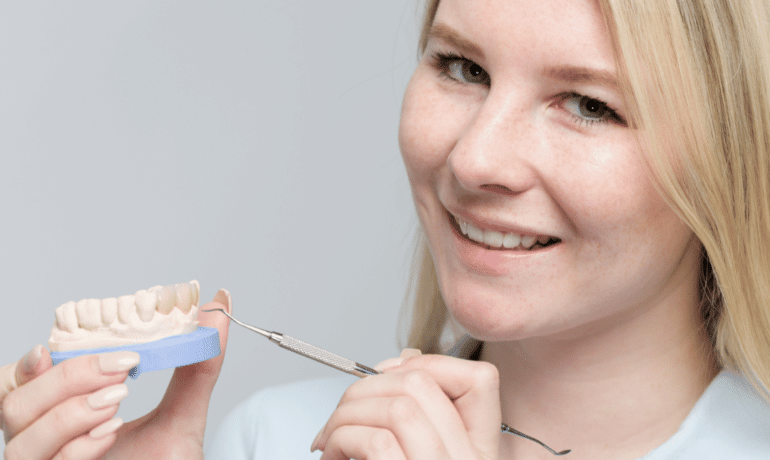Any imperfection in your smile can cause all kinds of distress. And even a slight discoloration in your dental crown can make you feel restless.
We’ve been dental professionals long enough and had countless patients who come to our office in Upland about cosmetic dental issues. One particular question we’re often asked is about patients’ discolored dental crowns.
Yes, tooth crowns can discolor too. The good news is that it’s a common problem with actionable solutions. So, if you’ve got your crowns looking like it had a rough day, we’ve got you covered! This article will cover the possible reasons why crowns change their appearance, and what you should do to maintain its natural shine.
Why Do Tooth Crowns Change Their Color?
For some patients, tooth crowns can turn from a pearly white to a light corn yellow. There are also reported cases where crowns can change their color to black.
These incidents often have varying causes, but most of them are hygiene-related ones. When we say hygiene-related, we’re referring to neglected teeth due to bad dental habits which often lead to tooth discoloration.
For instance, excessive consumption of stain-inducing beverages like coffee, red wine, and tea is a common cause of crown discoloration. Most dental crown materials, especially low-quality porcelain can be slightly porous. It means it can absorb stains from various substances, including coffee, tea, red wine, and certain foods.
Let’s not forget the most notorious cause of tooth discoloration in general—excessive smoking!
Dental staining is a common side effect of tobacco consumption. While the discoloration agents in tobacco smoking are yet to be quantified and perceived, dental staining in smokers is a common clinical observation.
A cross-sectional national survey was performed on a sample of 6,000 UK adults. A total of 3,384 adults participated in the interviews.
The results suggested that 28% of smokers reported having moderate or severe tooth discoloration, while only 15% of non-smokers did. Furthermore, smokers were more likely to perceive their teeth as discolored and to be unhappy with their tooth color compared to non-smokers.
Tooth Crowns Turning Black
Unfortunately, tooth crowns may also change their appearance due to some serious reasons. They may be a result of poor dental work, resulting in bacteria sticking around the gaps in the crown area. Darkening tooth crowns could also be associated with traumatic dental injuries.
A study suggested that some cases of discolored teeth, including crown discoloration, often indicate internal damage following dental trauma. Complications like nerve death, root absorption, and blocked root canals can cause discoloration.
In other words, discoloration in a dental crown can occur not only on the surface of the crown itself but also beneath it, particularly in the natural tooth structure beneath the crown.
Nonetheless, it’s always important to look out for these signs so you can easily determine the problem and receive proper treatment early on.
Speaking of treatment! Let’s talk more about what you can do to get those crowns looking natural again.
What to Do With a Discolored Crown
The way dental experts deal with a discolored dental crown may be different from how they approach teeth whitening. Crowns are made from materials such as porcelain or ceramic, which makes them unsuitable for traditional teeth whitening treatments.
To be sure, visit your dentist in Upland California to get expert advice and personalized treatment. That said, here are some of the practical solutions you might receive:
Polishing and Stain Removal
For minor surface discoloration, your dentist may be able to polish the crown or remove surface stains. This is non-invasive, but it’s only effective if the discoloration is on the surface and not related to deeper issues such as decay.
Professional Cleaning
If the discoloration is caused by plaque buildup or surface stains from food, drinks, or smoking, a professional cleaning might help. It’s important to note, though, that this will not lighten the crown but can only remove external stains.
Crown Replacement
When the discoloration is more extensive, such as internal staining from decay or a darkened tooth underneath, replacing the crown may be the best option. Crowns are typically designed to last 10–15 years, so if your crown is older or showing significant discoloration, replacement might be necessary.
In a word, there’s no silver bullet to whiten a tooth crown. Not even professional teeth whitening treatment can help restore a discolored crown. Likewise, there are no whitening products such as toothpaste to fix a discolored crown. If polishing and cleaning do not resolve the issue, replacing the crown may be the most effective solution, particularly if the crown is aging or if the underlying tooth structure is compromised.
How to Maintain Your Crown’s Pristine Condition
Keeping your crown in tip-top shape isn’t rocket science. Dental crown materials such as porcelain and ceramic have properties that make your teeth appear whiter. Keeping those pearly whites is just a matter of discipline, sticking with proper dental care, and getting good old dental visits.
Can’t get enough of coffee but afraid that staining will ruin your smile? Keep your coffee intake to a minimum. And remember to brush your teeth after taking a cup or two.
Have you been involved in a collision and you accidentally lost a tooth or maybe chipped your tooth crown? Go straight to your nearest dentist in Upland California to check for possible mouth injuries. Whether you need a crown replacement or seek treatment for crown-related pain, we’re here to help you.
Book a free consultation with us at Upland Dental Practice for your peace of mind!


